On Tuesday, December 16, 2014, NASA scientists attending the American Geophysical Union Fall Meeting in San Francisco announced the detection of organic compounds on Mars. The announcement represents the discovery of the missing “ingredient” that is necessary for the existence – past or present – of life on Mars.
Indeed, the extraordinary claim required extraordinary evidence – the famous assertion of Dr. Carl Sagan. The scientists, members of the Mars Science Lab – Curiosity Rover – mission, worked over a period of 20 months to sample and analyze Martian atmospheric and surface samples to arrive at their conclusions. The announcement stems from two separate detections of organics: 1) ten-fold spikes in atmospheric Methane levels, and 2) drill samples from a rock called Cumberland which included complex organic compounds.
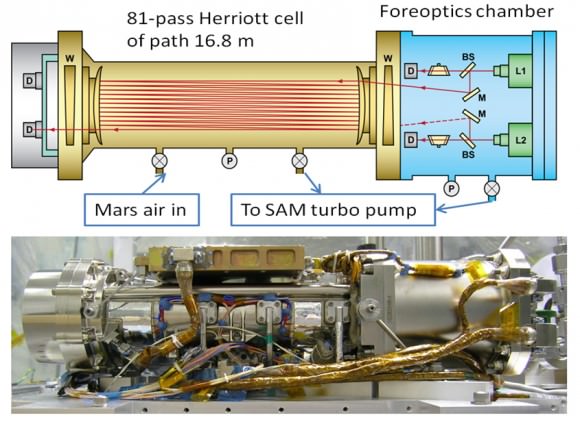
Methane, of the simplest organic compounds, was detected using the Sample Analysis at Mars instrument (SAM). This is one of two compact laboratory instruments embedded inside the compact car-sized rover, Curiosity. Very soon after landing on Mars, the scientists began to use SAM to periodically measure the chemical content of the Martian atmosphere. Over many samples, the level of Methane was very low, ~0.9 parts per billion. However, that suddenly changed and, as scientists stated in the press conference, it was a “wow” moment that took them aback. Brief daily spikes in Methane levels averaging 7 parts per billion were detected.
The detection of methane at Mars has been claimed for decades, but more recently, in 2003 and 2004, independent research teams using sensitive spectrometers on Earth detected methane in the atmosphere of Mars. One group led by Vladimir Krasnopolsky of Catholic University, and another led by Dr. Michael Mumma from NASA Goddard Space Flight Center, detected broad regional and temporal levels of Methane as high as 30 parts per billion. Those announcements met with considerable skepticism from the scientific community. And the first atmospheric measurements by Curiosity were negative. However, neither group backed down from their claims.
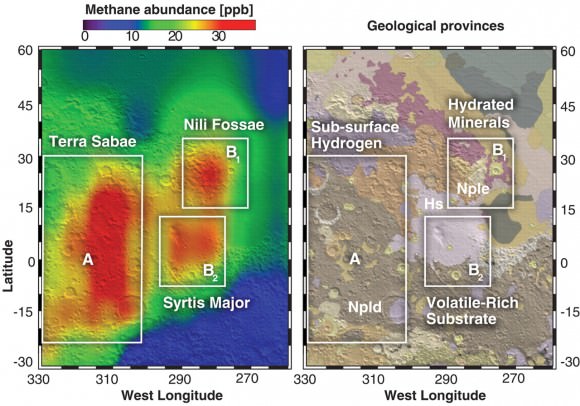
The sudden detection of ten-fold spikes in methane levels in Gale crater is not inconsistent with the earlier remote measurements from Earth. The high seasonal concentrations were in regions that do not include Gale Crater, and it remains possible that the Curiosity measurements are of a similar nature but due to some less active process than exists at the regions identified by Dr. Mumma’s team.
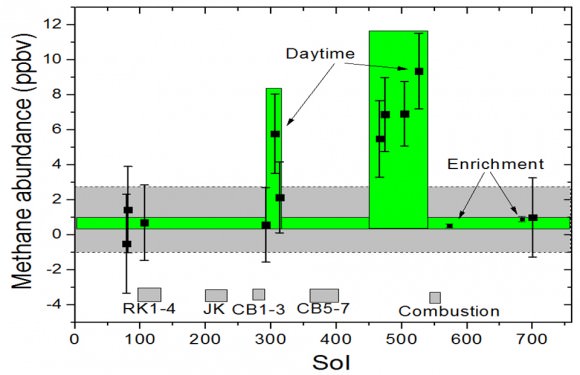
The NASA scientists at AGU led by MSL project scientist Dr. John Grotzinger emphasized that they do not yet know how the methane is being generated. The process could be biological or not. There are abiotic chemical processes that could produce methane. However, the MSL SAM detections were daily spikes and represent an active real on-going process on the red planet. This alone is a very exciting aspect of the detection.
The team presented slides to describe how methane could be generated. With the known low background levels of methane at ~ 1 part per billion, an external cosmic source, for example micro-meteoroids entering the atmosphere and releasing organics which is then reduced by sunlight to methane, could be ruled out. The methane source must be of local origin.

The scientists illustrated two means of production. In both instances, there is some daily – or at least periodic – activity that is releasing methane from the subsurface of Mars. The source could be biological which is accumulated in subsurface rocks then suddenly released. Or an abiotic chemistry, such as a reaction between the mineral olivine and water, could be the generator.
The subsurface storage mechanism of methane proposed and illustrated is called clathrate storage. Clathrate storage involves lattice compounds that can trap molecules such as methane which can subsequently be released by physical changes in the clathrate, such as solar heating or mechanical stresses. Through press Q&A, the NASA scientists stated that such clathrates could be preserved for millions and billions of years underground.
The second discovery of organics involved more complex compounds in surface materials. Also since arriving at Mars, Curiosity has utilized a drilling tool to probe the interiors of rocks. Grotzinger emphasized how material immediately at the surface of Mars has experienced the effects of radiation and the ubiquitous soil compound perchlorate reducing and destroying organics both now and over millions of years. The detection of no organics in loose and exposed surface material had not diminished NASA scientists’ hopes of detecting organics in the rocks of Mars.
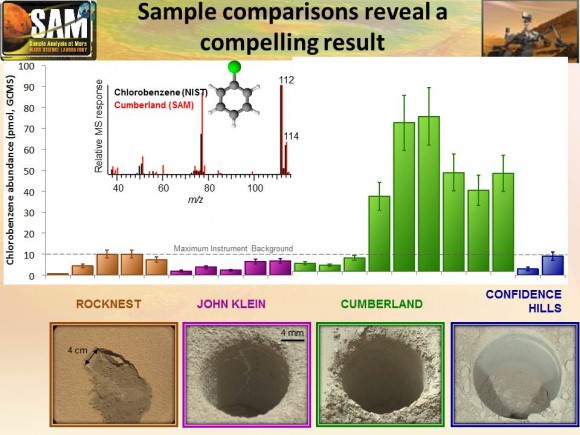
Drilling was performed on several selected rocks and it was finally a mud rock called Cumberland that revealed the presence of organic compounds more complex than simple methane. The scientists did emphasize that what exactly these organic compounds are remains a mystery because of the confounding presence of the active chemical perchlorate which can quickly breakdown organics to simpler forms.
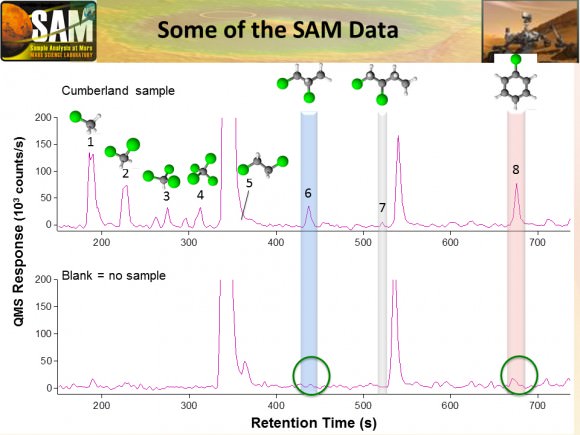
(Image Credit: NASA/JPL-Caltech)
The detection of organics in the mud rock Cumberland required the drilling tool and also the scoop on the multifaceted robotic arm to deliver the sample into the SAM laboratory for analysis. To detect methane, SAM has an intake valve to receive atmospheric samples.
Dr. Grotzinger described how Cumberland was chosen as a sample source. The rock is called a mud stone which has undergone a process called digenesis – the metamorphosis of sediment to rock. Grotzinger emphasized that fluids will move through such rock during digenesis and perchlorate can destroy organics in the process. Such might be the case for many metamorphic rocks on the Martian surface. The panel of scientists showed a comparison between rock samples measured by SAM. Two in particular – from the rock “John Klein” and the Cumberland rock — were compared. The former showed no organics as well as other rocks that were sampled; but Cumberland’s drill sample from its interior did reveal organics.
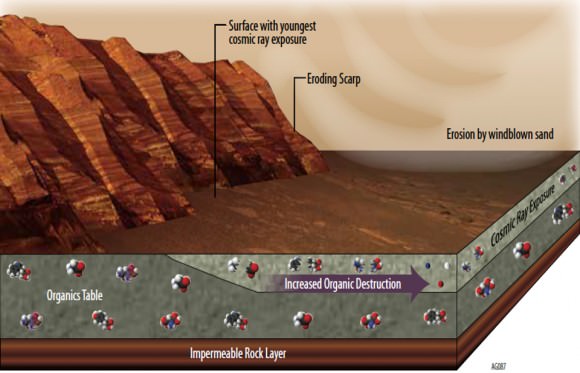
The analysis of the work was painstaking – harking back to the Sagan statement. The importance of discovering organics on Mars could not be understated by the panel of scientists and Grotzinger called these two discoveries as the lasting legacy of the Mars Curiosity Rover. Furthermore, he stated that the discovery and analysis methods will go far to guide the choice of instruments and their use during the Mars 2020 rover mission.
The discovery of organics completes the necessary set of “ingredients” for past or present life on Mars: 1) an energy source, 2) water, and 3) organics. These are the basic requirements for the existence of life as we know it. The search for life on Mars is still just beginning and the new discoveries of organics is still not a clear sign that life existed or is present today. Nevertheless, Dr. Jim Green, introducing the panel of scientists, and Dr. Grotzinger both emphasized the magnitude of these discoveries and how they are tied into the objectives of the NASA Mars program — particularly now with the emphasis on sending humans to Mars. For the Mars Curiosity rover, the journey up the slopes of Mount Sharp continues and now with greater earnestness and a continued search for rocks similar to Cumberland.
References:
Curiosity detects methane spike on Mars
NASA Rover Finds Active, Ancient Organic Chemistry on Mars
Research Papers, AGU Press Conerence via Ustream
Strong Release of Methane on Mars in Northern Summer 2003
Non-Detection of Methane in the Mars Atmosphere by the Curiosity Rover
Detection of methane in the martian atmosphere: evidence for life?


Wow… this is incredible news! There have been several ‘turn arounds’ concerning possible methane detection on Mars with a lot of uncertainty surrounding each claim – ambiguous at best. Now this! Way cool!
It has been known since 2003 that at least part of Mars’ interior is molten, based on how easily the Sun’s gravity distorts the planet’s shape. A possible energy source for methane production? If there were a heat source near the surface somewhere it might keep an aquifer(s) liquid? Life there? Lets say that crustal fracturing due to asteroid or cometary impact provides a conduit for magma to rise near the surface. Would there be a stable environment for liquid water there? Could that thermal source could be tapped for power?
Regardless, these are very interesting findings!
NASA Scientists are not at liberating to assume the existence of aquifers (liquid water) and conduct science. For the rest of us, we can consider the physics of the matter. If I recall correctly, liquid water will exist at 20 meter depth on mars due to the pressure/weight of the rock above. Life on earth exists at depths of miles under ground. Yes just as the Sun imparts tidal forces on earth, mars experiences the same. The eccentricity of mars orbit causes a greater variation in those tidal forces. Also the tilt of mars varies so greatly over eons, tidal forces would vary even more on any interior formations. The release of methane adds to our understanding that Mars is active and not a dead planet. For those excited about a journey to Mars, they must be dreaming of jumping oh the next barge to Mars. Thanks for sharing your comments and ideas!
I just read over at ‘Brand X’ aka SPACEFLIGHT 101, a story about the new Raptor engine SpaceX is building. They are going from a LOX/RP fuel to a LOX/CH4 (Methane) fuel. With Mars in mind, they intend to use a Sabatier reactor to produce methane on the surface of Mars? I think they should build a prototype and put it on the next/2020 Mars lander! Just for grins they might be able to make enough fuel to power a sample return rocket?
Curiosity Rover detects Methane – ‘Tis a Martian fart.
So this is not really a “new discovery” or development; it is simply a CONFIRMATION of what other instruments from other researchers have been claiming all along. The only thing really note worthy is that Curiosity has provided the “extraordinary evidence” appropriate for this type of claim. It will be very interesting when this level of investigation and proof is brought to bear in areas which have indicated as much as 30 parts per billion according to other research methods. I would think that THOSE areas would be the places to do further research on the causes of these organics on Mars. So few rovers … so many places to investigate … What a great time to live in!
Looking back to the original methane detection, although the highest concentrations were further west in 2009, there was some emission in the band crossing Gale crater at the summer solstice, less at the autumn equinox. Relating that to the Curiosity detection dates, the smaller outburst around Sol 300 was before the spring equinox, but the bigger one bracketing Sol 500 runs up to the summer solstice. This looks real!
Duncan. Excellent. Thanks for adding this additional detail.
Thanks Tim. I didn’t notice the possible significance of the dates until after I’d been interviewed about the story on BBC Scotland, and It broke just after I’d reviewed Rod Pyle’s “Curiosity” for Concatenation. I’m about to send them a revised version! What I’ve been looking for and can’t find so far, is Mars methane observations for the summer solstice of March 2012 – just articles saying ‘Curiosity will settle the question’. Right now we have peaks in 2009 and 2014 – could be volcanic, but why should volcanic activity be tied in with the solstices? To paraphrase “Live and Let Die”, once could be happenstance, twice could be coincidence, but three times looks like biological action!